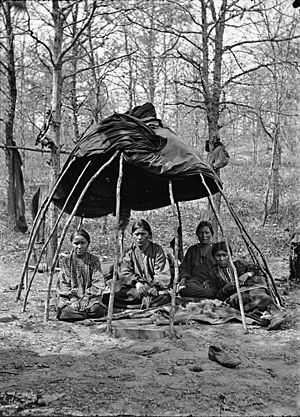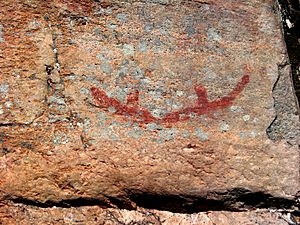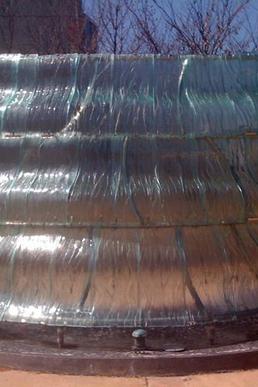Truman Lowe facts for kids
Quick facts for kids
Truman Lowe
|
|
|---|---|
| Born |
Truman Lowe
January 19, 1944 Black River Falls, Wisconsin
|
| Died | (aged 75) |
| Nationality | Ho-Chunk |
| Education | B.S. University of Wisconsin–La Crosse, M.F.A. University of Wisconsin–Madison |
| Patron(s) | Eiteljorg Museum of American Indians and Western Art, Museum of Wisconsin Art, National Museum of the American Indian, Indianapolis Art League, John Lavine, Denver Art Museum, Peabody Essex Museum |
Truman Tennis Lowe (born January 19, 1944 – died March 30, 2019) was a famous American artist. He was a member of the Ho-Chunk Nation. Truman Lowe was known for making amazing sculptures and large art pieces called installation art. These artworks often used natural materials. He was also a professor of fine art at the University of Wisconsin. Later, he became a curator of modern art at the National Museum of the American Indian.
Contents
Truman Lowe's Early Life and Education
Growing Up Ho-Chunk
Truman Lowe was born on January 19, 1944. His hometown was Black River Falls, Wisconsin. This area is part of the Ho-Chunk Nation of Wisconsin reservation. He was the youngest of six children. His parents were Mabel Davis and Martin Lowe.
His mother, Mabel, worked as a cook and laundress. His father, Martin, was a farmer. He also traveled to pick blueberries and cranberries. Truman grew up speaking the Winnebago language at home. He went to the Black River Indian Mission school until sixth grade. In 1957, he moved to a public school in Black River Falls.
Summer Jobs and Stereotypes
Starting in 1960, Truman worked summers at the Wisconsin Dells. He would "play Indian" for tourists. He wore an "Indian costume" to greet visitors. He also guided tours on boats. These experiences with stereotypes later influenced his art.
Pursuing Higher Education
After high school, Truman went to the University of Wisconsin–La Crosse. He first studied art education. He learned about many types of fine art. In 1964, he took a break to work in a factory.
In 1966, he married Nancy Knabe. She was of European-American descent. Nancy taught high school while Truman finished his degree. After graduating, Truman taught art for two years. He also worked on his own art.
He then got a fellowship to study at the University of Wisconsin–Madison. He earned his master's degree in fine arts. Their daughter, Tonia Alison, was born in 1971. Truman wanted to learn as much as possible. He felt this would help him be a better teacher.
Teaching and Museum Work
After getting his master's in 1973, Truman taught at Emporia State University in Kansas. Two years later, he returned to Madison. He became an assistant dean at the University of Wisconsin. In 1975, his son, Martin Howard, was born. That same year, Truman became an assistant professor of sculpture. He also worked in the Native American studies program.
Truman became a full professor of art in 1989. He even led the art department from 1992 to 1995. In 2000, he took a break from teaching. He became the curator of contemporary art for the National Museum of the American Indian. He helped set up the museum's first exhibition in Washington, D.C. He worked there until 2008.
Truman Lowe's Art Career and Influences
Family and Ho-Chunk Roots
As a child, Truman loved collecting rocks. He would scratch them together to make drawings. He even tried grinding rocks for paint. He also drew "how snow sits on trees." In high school, he spent study hall in the art room.
His parents made crafts to earn extra money. His mother wove split-ash baskets. His father made the handles. Both also did beadwork. Truman learned these skills too. They sold their crafts to tourists. This helped their family during seasonal farm work.
Truman grew up seeing art as an everyday activity. He didn't know about the Western idea of art as a full-time job. He later learned about Western art history in college. He realized artists could make a living from their work. He admired Michelangelo for this reason.
Early Art Experiments
Truman's early art was shaped by his college studies. He made abstract paintings. He also created egg-shaped clay sculptures. He learned about the power of lines in art. He studied artists like Brâncuși and Henry Moore.
In the 1960s, plastic was popular. Truman used it to make a life-size toaster sculpture. His first large art piece was Laundry Bags (1969). It showed clear plastic trash bags filled with colored rags. This large-scale style became a key part of his future work.
He loved experimenting with plastic. He used it as a canvas, drawing with markers. His simple works explored ideas like transparency and pictorial depth. His master's exhibition in 1973 featured these plastic installations. He wanted viewers to move through the art. He didn't want them to see each piece as a separate object.
Meeting artist George Morrison was important for Truman. Morrison was also from the Midwest. He showed Truman how to connect with both Native and non-Native art worlds.
Finding His Voice in Kansas
In 1973, Truman moved to Kansas for a teaching job. He lived on a farm. He soon realized he missed Wisconsin's landscape. He felt like a "Woodland Indian." This time away helped him connect with his heritage. He started using natural materials like wood. He stopped using synthetic materials completely.
This change fit with the "back-to-the-land movement" of the time. Truman began to combine his family's woodworking and basketry skills with modern art.
Returning to Wisconsin
When Truman returned to Wisconsin, his art became known as contemporary Indian art. He explained how his work used Native techniques and traditions. His art in the late 1970s explored "traditional Indian techniques." He made war shields with feathers. Feathers are powerful symbols in many Native communities. They became important in his art.
Art as Storytelling
Like many Native American artists, Truman used his art to tell stories. His work helped keep Native cultures alive. His large wooden sculpture Red Banks (1991) tells the story of the Winnebago people's beliefs. It is 12 by 37 by 8 feet. Red Banks shows how oral traditions and myths help cultures survive.
Truman believed artists play a key role in preserving culture. He said they help non-Indians learn about Winnebago culture. Other works also tell stories. Wooden Pole Construction (1983) remembers the smallpox epidemic of 1901. Feather Tree (1990) honors his grandmother. Truman also made drawings to honor his mother.
Honoring Native History
Many of Truman's works honor traditional Native art. He drew inspiration from the Winnebago and other Native American groups. His Headdress Series was inspired by traditional Plains Indian clothing. He also made sculptures based on early Woodland shelters.
He used old photographs from the Wisconsin State Historical Society. For example, his work Cradle Board (1977–78) was inspired by photos of cradle boards. These images helped him research Native housing and community life.
Truman's sculptures of old structures made him think about cultures disappearing. Their simple, yet complex, designs felt like "ghosts" of the past. He said in 1986, "My real interest is structures, the sculptural aspect of primitive structures...what intrigues me is that something is very primitive yet at the same time, very universal."
His later works explored bigger ideas. Influenced by his son's interest in astronomy, he created the Solstice and Skychart series. These works showed abstract star charts. They were inspired by how people explored new places using the sky.
Major Works and Symbols in Truman Lowe's Art
Red Ochre Series
In 1991, Truman started a series of large art pieces called Red Ochre. The first one was in Atlanta, Georgia. It explored ideas about human migration and ancient burial sites. It showed how cultures, rituals, and journeys blend over time.
The second Red Ochre piece was at the Eiteljorg Museum of American Indians and Western Art in Indianapolis, Indiana in 1993. This work included images of rock art. Truman believed rock art was a way for cultures to communicate across the world. He even invited the public to help build this piece.
Both Red Ochre installations used natural materials. These included young trees (saplings) and brown paper. The paper gave a rock-like texture. The Atlanta work was like an exploratory forest. The Eiteljorg work focused on murals and wall designs.
Canoes: Journeys and Shelter
Truman Lowe loved canoeing. He said, "If I have a religion, it must be canoeing." The canoe is a classic symbol of Native America. Truman used it in his art to go beyond simple stereotypes. He saw the canoe as both a shelter and a vehicle. Many of his canoe sculptures look like wigwams. They are wooden skeletons with curved shapes. Smaller sculptures also represent canoes.
Canoes in his art symbolize journeys, from birth to death.
Water: Flow and Fragility
Truman often used images of water in his art. This included his canoe pieces. In his Water Spirits series, he wanted to show respect for nature and spiritual forces. He used wood pieces and debris. These reflected seasonal changes and the fragility of nature. They also showed the importance of water's flow.
In 1992, he created a sculpture for Cloquet Community College. It was made of polished stainless steel. It flowed through pine trees like a stream. You could even sit on it. Thin slits in the steel showed large rocks from nearby rivers. This represented flowing water.
Other water-related works include Ottawa (1992). It shows how water flows quickly down steep slopes. It has rows of unfinished wood strips that look like a fast stream. It reflects the relationship between the river and its surroundings.
His sculptures also show shorelines and streambeds. Water Mound (1994) is a huge wooden installation. It represents sandbars that form in rivers. Maumee Reflection (1987) shows where land meets water. This piece was displayed where three rivers meet in Fort Wayne, Indiana.
Many of his water works also include elements of basketry. He used wood splints, like those used to shape baskets. This showed another connection to his family's craft traditions.
Grids: Mapping and History
Truman Lowe sometimes used grids in his art. This was similar to modern artists like Sol LeWitt. He used grids to represent mapping systems. These were ways to describe landscapes in a flat, two-dimensional way. Native American communities did not traditionally make maps like Europeans. Europeans used grids to divide land for settlers. Truman also used grids to symbolize archaeological digs. They appear in his large landscape works like Effigy I (1984).
Wood: Natural Material
Many of Truman's sculptures are made from willow saplings. He often used only this material. He collected the saplings from Wisconsin farms in the summer. He would peel off the bark and sand the wood. This brought out the white color. Willow is flexible and strong. This allowed him to bend and shape the wood as he needed.
Public Collections
- Chazen Museum of Art, Madison, WI
- Crow's Shadow Institute of the Arts, Pendleton, OR
- Des Moines Art Center, Des Moines, IA
- Denver Art Museum, Denver, CO
- Eiteljorg Museum of American Indians and Western Art, Indianapolis, IN
- Fond du Lac Tribal and Community College, Cloquet, MN
- Fort Lewis College, Durango, CO
- Fort Wayne Museum of Art, Fort Wayne, IN
- Heard Museum, Phoenix, AZ
- Hood Museum of Art, Hanover, N.H.
- Indianapolis Art Center, Indianapolis, IN
- Kellog School of Management, Northwestern University, Evanston, IL
- Madison Museum of Contemporary Art, Madison, WI
- McCormick Place Convention Center, Chicago, IL
- Metropolitan Museum of Art, New York, NY
- Milwaukee Art Museum, Milwaukee, WI
- Museum of Contemporary Art, Chicago, IL
- Museum of Contemporary Native Arts, Santa Fe, N.M.
- Museum of Wisconsin Art, West Bend, WI
- National Cowboy and Western Heritage Museum, Oklahoma City, OK
- National Museum of the American Indian, Washington, D.C.
- Nature at the Confluence, South Beloit, IL
- Peabody Essex Museum, Salem, MA
- Plains Art Museum, Fargo, ND
- Portland Art Museum, Portland, OR
- Rockwell Museum, Corning, NY
- Smith College Museum of Art, Northampton, MA
- Smithsonian American Museum of Art, Washington, D.C.
- Tucson Museum of Art, Tucson, AZ
- Tweed Museum of Art, University of Minnesota - Duluth, MN
Major Exhibitions
- Changing Currents: The Art of Truman Lowe, 2020, Art Gallery, University of Wisconsin - La Crosse, WI
- Cultural Confluence: Work by Truman Lowe, 2017, Plains Art Museum, Fargo, ND
- Truman Lowe: Limn, 2010, Museum of Wisconsin Art, Bend, WI
- Vantage Point, 2010, National Museum of the American Indian, Washington, D.C.
- Remembrance, 2001, Madison Museum of Contemporary Art, Madison, WI
- Nigachiwong: Swirling Waters, 2001, Tweed Museum of Art, University of Minnesota - Duluth, MN
- Between the Lakes: Artists Respond to Madison, 2006, Madison Museum of Contemporary Art
- Neo-Xahnee, 1999-2000, John Michael Kohler Arts Center, Sheboygan, WI
- Honoring Native America, 1998, White House, Washington, D.C.
- Powerful Images: Portrayals of Native America, 1998, National Cowboy & Western Heritage Museum
- From the Shadows of the River, 1996, Clara M. Eagle Art Gallery, Murray State University, Murray, KY
- Haga (Third son), 1994, Eiteljorg Museum of American Indians and Western Art, Indianapolis, IN
- 8 Native American Artists, 1988, Fort Wayne Museum of Art, Fort Wayne, IN
Selected Awards, Grants and Honors
- Posthumous Lifetime Achievement Award, 2019, Native American Art Studies Association
- Distinguished Alumni Award, 2008, Wisconsin Alumni Association, University of Wisconsin
- Wisconsin Visual Art Lifetime Achievement Award, 2007, Wisconsin Arts Board
- Wisconsin Academy of Sciences, Arts and Letters, 2005
- Eiteljorg Fellowship, 1999, Eiteljorg Museum of American Indians and Western Art
- Outstanding Alumni Award, 1999, University of Wisconsin - La Crosse
- WARF Mid-Career Faculty Research Award, 1997, University of Wisconsin - Madison
- National Endowment for the Arts Individual Fellowship, 1994-1995, National Endowment for the Arts
- Chancellor's Development Grant, 1991-1992, University of Wisconsin - Madison
- Wisconsin Arts Board Project Grant, 1989
- Honorary Fellow, 1987, Phi Kappa Phi Honor Society
- Chancellor's Development Award in the Creative Arts, 1985-1990, University of Wisconsin - Madison
- Named "Outstanding Citizen" by Madison Civics Club, 1985
- Governor's Heritage Award, 1984, State of Wisconsin
- Ford Foundation Doctoral Fellowship, 1971-1973, Ford Foundation




